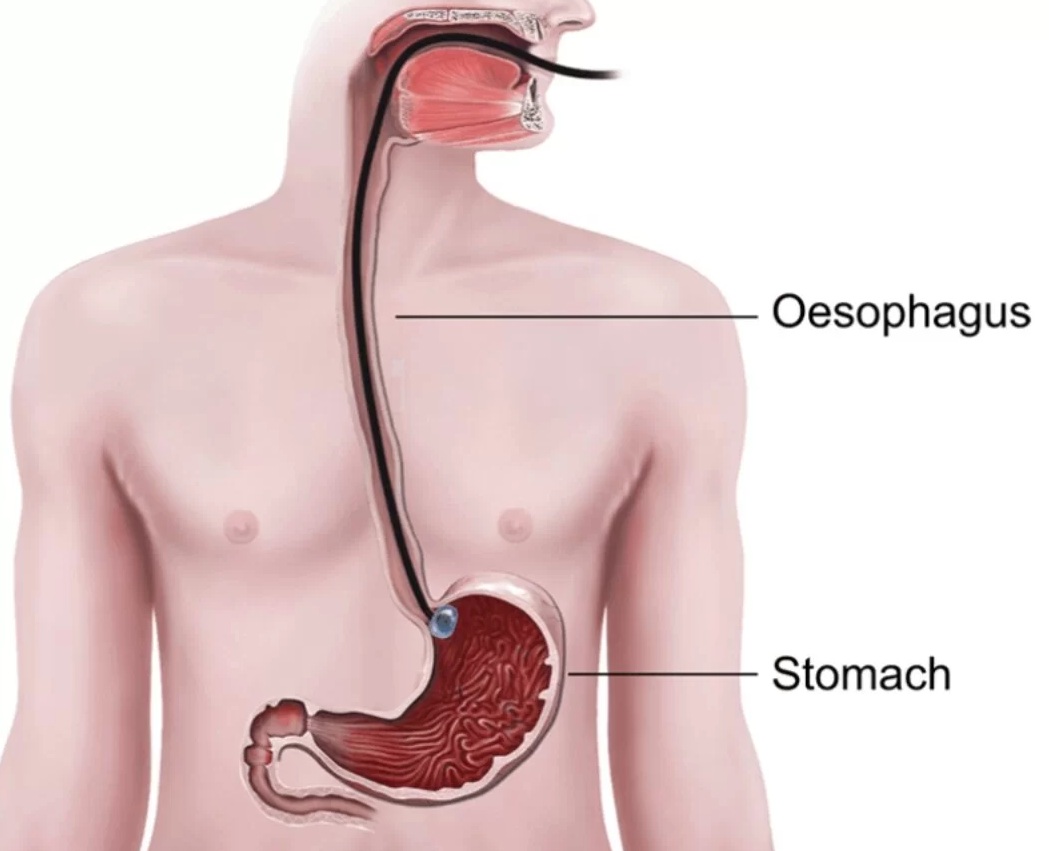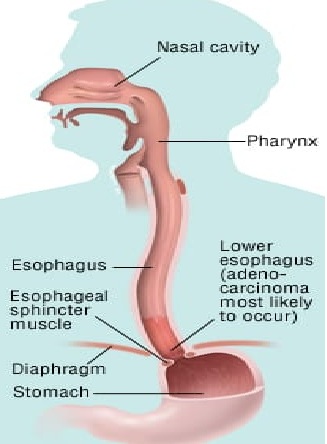Esophageal cancer or Carcinoma of esophagus
The esophagus is the hollow, muscular tube that moves food and liquid from the throat to the stomach. The wall of the esophagus is made up of several layers of tissue, including mucous membrane, muscle, and connective tissue. Esophageal cancer starts on the inside lining of the esophagus and spreads outward through the other layers as it grows.
Esophageal carcinoma is a rare cancer that develops in the tissues of the esophagus, the tube that moves food and liquids from the throat to the stomach. Squamous carcinoma of esophagus is the commonest malignancy in esophagus, common site being lower 1/3rd followed by middle and upper 1/3rd. The lesion is usually ulcerative and expands circumferentially and longitudinally in the wall of esophagus. Average age is between 60 and 70 years with male prominence. Associated factors include smoking, alcohol consumption and spices.
Types of Carcinoma of Esophagus
Adenocarcinoma
This type of cancer forms in the glandular cells that line the esophagus and produce fluids like mucus. Adenocarcinomas usually develop in the lower part of the esophagus, near the stomach.
Squamous cell carcinoma
This type of cancer forms in the flat cells that line the inside of the esophagus. Squamous cell tumors are most often found in the upper and middle part of the esophagus, but can occur anywhere.
Three ways that cancer spreads in the body
Cancer can spread through tissue, the lymph system, and the blood.
Tissue
The cancer spreads from where it began by growing into nearby areas.
Lymph system
The cancer spreads from where it began by getting into the lymph system. The cancer travels through the lymph vessels to other parts of the body.
Blood
The cancer spreads from where it began by getting into the blood. The cancer travels through the blood vessels to other parts of the body.
Cancer may spread from where it began to other parts of the body
When cancer spreads to another part of the body, it is called metastasis. Cancer cells break away from where they began (the primary tumor) and travel through the lymph system or blood.
Lymph system
The cancer gets into the lymph system, travels through the lymph vessels, and forms a tumor (metastatic tumor) in another part of the body.
Blood
The cancer gets into the blood, travels through the blood vessels, and forms a tumor (metastatic tumor) in another part of the body.
The metastatic tumor is the same type of cancer as the primary tumor. For example, if esophageal cancer spreads to the lung, the cancer cells in the lung are actually esophageal cancer cells. The disease is metastatic esophageal cancer, not lung cancer.
Symptoms of Carcinoma of Esophagus
Difficulty swallowing
Chest pain
Heartburn
Vomiting blood
Weight loss
Regurgitation
(Regurgitation is when food moves backward through the esophagus and possibly into the mouth)
Clinical features of Carcinoma of Esophagus
Progressive dysphagia, weight loss
Discomfort not amounting to pain.
Mediastinal lymphadenopathy with cough, dyspnea.
Stages of Esophageal Cancer
After esophageal cancer has been diagnosed, tests are done to find out if cancer cells have spread within the esophagus or to other parts of the body. There are three ways that cancer spreads in the body. Cancer may spread from where it began to other parts of the body. The grade of the tumor is also used to describe the cancer and plan treatment.
The following stages are used for squamous cell carcinoma of the esophagus
Stage 0 (High-grade Dysplasia)
Stage I squamous cell carcinoma of the esophagus
Stage II squamous cell carcinoma of the esophagus
Stage III squamous cell carcinoma of the esophagus
Stage IV squamous cell carcinoma of the esophagus
The following stages are used for adenocarcinoma of the esophagus
Stage 0 (High-grade Dysplasia)
Stage I adenocarcinoma of the esophagus
Stage II adenocarcinoma of the esophagus
Stage III adenocarcinoma of the esophagus
Stage IV adenocarcinoma of the esophagus
Esophageal cancer can recur (come back) after it has been treated.
The grades of the tumor
The grade of the tumor describes how abnormal the cancer cells look under a microscope and how quickly the tumor is likely to grow and spread. Grades 1 to 3 are used to describe esophageal cancer:
In grade 1
The cancer cells look more like normal cells under a microscope and grow and spread more slowly than grade 2 and 3 cancer cells.
In grade 2
The cancer cells look more abnormal under a microscope and grow and spread more quickly than grade 1 cancer cells.
In grade 3
The cancer cells look more abnormal under a microscope and grow and spread more quickly than grade 1 and 2 cancer cells.
Diagnosis of Carcinoma of Esophagus
Physical exam and health history
An exam of the body to check general signs of health, including checking for signs of disease, such as lumps or anything else that seems unusual. A history of the patient’s health habits and past illnesses and treatments will also be taken.
Chest x-ray and Barium swallow
An x-ray of the organs and bones inside the chest. An x-ray is a type of energy beam that can go through the body and onto film, making a picture of areas inside the body.
Ultrasound examination
A procedure in which high-energy sound waves (ultrasound) are bounced off internal tissues or organs, such as those in the neck, and make echoes. The echoes form a picture of body tissues called a sonogram. The picture can be printed to be looked at later.
CT scan (CAT scan)
A procedure that makes a series of detailed pictures of areas inside the body, such as the chest, abdomen, and pelvis, taken from different angles. The pictures are made by a computer linked to an x-ray machine. A dye may be injected into a vein or swallowed to help the organs or tissues show up more clearly. This procedure is also called computed tomography, computerized tomography, or computerized axial tomography.
Esophagoscopy / Endoscopy / UGI scope (Upper Gastero-Intestinal scope)
Endoscopy helps in visualization and biopsy of carcinoma. A procedure to look inside the esophagus to check for abnormal areas. An esophagoscope is inserted through the mouth or nose and down the throat into the esophagus. An esophagoscope is a thin, tube-like instrument with a light and a lens for viewing. It may also have a tool to remove tissue samples, which are checked under a microscope for signs of cancer. When the esophagus and stomach are looked at, it is called an upper endoscopy.
MRI (Magnetic Resonance Imaging)
A procedure that uses a magnet, radio waves, and a computer to make a series of detailed pictures of areas inside the body. This procedure is also called nuclear magnetic resonance imaging (NMRI).
PET scan (Positron Emission Tomography scan)
A procedure to find malignant tumor cells in the body. A small amount of radioactive glucose (sugar) is injected into a vein. The PET scanner rotates around the body and makes a picture of where glucose is being used in the body. Malignant tumor cells show up brighter in the picture because they are more active and take up more glucose than normal cells do. A PET scan and CT scan may be done at the same time. This is called a PET-CT.
Thoracoscopy
A surgical procedure to look at the organs inside the chest to check for abnormal areas. An incision (cut) is made between two ribs and a thoracoscope is inserted into the chest. A thoracoscope is a thin, tube-like instrument with a light and a lens for viewing. It may also have a tool to remove tissue or lymph node samples, which are checked under a microscope for signs of cancer. In some cases, this procedure may be used to remove part of the esophagus or lung.
Endoscopic ultrasound (EUS)
A procedure in which an endoscope is inserted into the body, usually through the mouth or rectum. For esophageal cancer, the endoscope is inserted through the mouth. An endoscope is a thin, tube-like instrument with a light and a lens for viewing. A probe at the end of the endoscope is used to bounce high-energy sound waves (ultrasound) off internal tissues or organs and make echoes. The echoes form a picture of body tissues called a sonogram. A biopsy may also be done. This procedure is also called endosonography.
Laparoscopy
A surgical procedure to look at the organs inside the abdomen to check for signs of disease. Small incisions (cuts) are made in the wall of the abdomen and a laparoscope (a thin, lighted tube) is inserted into one of the incisions. Other instruments may be inserted through the same or other incisions to perform procedures such as removing organs or taking tissue samples to be checked under a microscope for signs of disease.
Biopsy
The removal of cells or tissues so they can be viewed under a microscope by a pathologist to check for signs of cancer. The biopsy is usually done during an esophagoscopy. Sometimes a biopsy shows changes in the esophagus that are not cancer but may lead to cancer.
Treatment for Carcinoma of Esophagus
Surgery
Surgery is the most common treatment for cancer of the esophagus. Part of the esophagus may be removed in an operation called an esophagectomy.
Endoscopic mucosal resection.
Squamous carcinoma lower 1/3rd
(i) Surgery (esophagogastrostomy)
(ii) Preoperative radiotherapy plus surgery.
Adenocarcinoma surgery plus postoperative radiotherapy.
Post operative dilatation required in all cases.
Insertion of prosthesis (e.g. colistin tube) allows swallowing liquids and saliva (for palliation)
Radiation therapy
Radiation therapy is a cancer treatment that uses high-energy x-rays or other types of radiation to kill cancer cells or keep them from growing. There are two types of radiation therapy:
External radiation therapy uses a machine outside the body to send radiation toward the area of the body with cancer.
Internal radiation therapy uses a radioactive substance sealed in needles, seeds, wires, or catheters that are placed directly into or near the cancer.
The way the radiation therapy is given depends on the type and stage of the cancer being treated. External and internal radiation therapy are used to treat esophageal cancer.
A plastic tube may be inserted into the esophagus to keep it open during radiation therapy. This is called intraluminal intubation and dilation.
Chemotherapy
Chemotherapy is a cancer treatment that uses drugs to stop the growth of cancer cells, either by killing the cells or by stopping them from dividing. When chemotherapy is taken by mouth or injected into a vein or muscle, the drugs enter the bloodstream and can reach cancer cells throughout the body (systemic chemotherapy). When chemotherapy is placed directly into the cerebrospinal fluid, an organ, or a body cavity such as the abdomen, the drugs mainly affect cancer cells in those areas (regional chemotherapy). The way the chemotherapy is given depends on the type and stage of the cancer being treated.
Chemoradiation therapy
Chemoradiation therapy combines chemotherapy and radiation therapy to increase the effects of both.
Laser therapy
Laser therapy is a cancer treatment that uses a laser beam (a narrow beam of intense light) to kill cancer cells.
Electrocoagulation
Electrocoagulation is the use of an electric current to kill cancer cells.
Immunotherapy
Immunotherapy is a treatment that uses the patient’s immune system to fight cancer. Substances made by the body or made in a laboratory are used to boost, direct, or restore the body’s natural defenses against cancer.
Immune checkpoint inhibitor therapy is a type of immunotherapy being studied to treat patients with advanced esophageal cancer that cannot be removed by surgery and recurrent esophageal cancer. Some types of immune cells, such as T cells, and some cancer cells have certain proteins, called checkpoint proteins, on their surface that keep immune responses in check. When cancer cells have large amounts of these proteins, they will not be attacked and killed by T cells. Immune checkpoint inhibitors block these proteins and the ability of T cells to kill cancer cells is increased.
Risk factors for esophageal cancer
Smoking
Heavy alcohol consumption
Chronic heartburn or acid reflux
Gastroesophageal reflux disease (GERD)
Barrett’s esophagus
Achalasia, a rare disorder of muscles in the lower esophagus
Obesity
Prognosis of Carcinoma of Esophagus
Prognosis is poor, overall 5 year survival rate 50% with a 5-year survival rate of less than 5%. The survival rate depends on the stage of the cancer.
The prognosis and treatment options
The stage of the cancer (whether it affects part of the esophagus, involves the whole esophagus, or has spread to other places in the body).
Whether the tumor can be completely removed by surgery.
The patient’s general health.
When esophageal cancer is found very early, there is a better chance of recovery. Esophageal cancer is often in an advanced stage when it is diagnosed. At later stages, esophageal cancer can be treated but rarely can be cured. Taking part in one of the clinical trials being done to improve treatment should be considered.
medlight2u.com
A light on Practice of Medicine (The information provided is for informational and educational purposes only and should not be considered professional advice)
- Presbyopia meaning “old eye”
- Oral cancer
- Gestational Trophoblastic Neoplasia (GTN)
- Brain tumors
- Perinatal Mood and Anxiety Disorders (PMADs)
Great content! Super high-quality! Keep it up!
I’m so in love with this. You did a great job!!
new texts were rewritten
The articles you write help me a lot and I like the topic
Acne Acne vulgaris Acute Renal Failure Adrenal cortex Angina Angina Pectoris Aortic Regurgitation (AR) Aortic Stenosis (AS) Chest pain Chronic pyelonephritis Coarctation of Aorta Cough cyanosis Cystic acne Dehydration depression Diabetes Mellitus Diagnosis of Aortic Stenosis Dr.KTS DR K TAMILSELVAN Fatigue Heart Failure Hypertension Hypokalemia Hypothyroidism Ischemic Heart Disease LBBB Mitral Incompetence Mitral insufficiency Mitral valve prolapse Nocturia Patent Ductus Arteriosus PDA Polyuria Proteinuria pulmonary hypertension Pulmonary Stenosis ST Depression Symptoms of Acne Syncope Treatment for acne valvular heart disease Ventricular Septal Defect VSD Zits





Can you write more about it? Your articles are always helpful to me. Thank you!